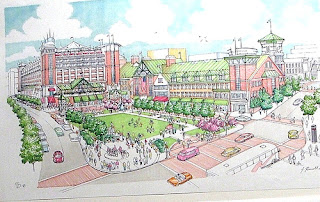
Could Wheaton look like this someday?
So why have we been talking about Wheaton? After all, this blog is called Maryland Politics Watch, not Wheaton Watch. There are two reasons.
First, Holly Olson, author of the prior three postings, is my long-suffering wife. To get a sense of that suffering, imagine having to hear maximum-volume rantings about such things as the Baroness of Montgomery 24-7. One reason I blog is because she ordered me to “get it out of your system.” The least I can do is return the favor and give her a conduit for expressing her thoughts, which are infinitely better-formed than mine.
But second, and much more importantly, Wheaton represents the future of Montgomery County, the state of Maryland and the United States. Its bustling, chaotic streets, its teeming masses of every language and color and its combination of private-sector optimism and skepticism of government hearken back to our roots of a century ago. If we can bring Wheaton to its full potential, we will have a formula that could be applied broadly to every main street in America.
For those of you who are unfamiliar with Wheaton, it lies at the junction of three of Montgomery County’s great avenues: Georgia Avenue, University Boulevard and Veirs Mill Road. Along with Silver Spring and Takoma Park, it is one of the county’s three truly diverse urban centers.
Wheaton does not have the prosperity or sheer population size of Silver Spring. It does not have the municipal government of Takoma Park. But it does have a friendly, welcoming spirit along with astounding diversity. In one small shopping center along University Boulevard, two Jewish food establishments co-exist with a Thai grocery, a Chinese restaurant and a Pho kitchen. Right across the street are a couple Latino restaurants. An Italian pizza joint is on the next block up and a Korean restaurant is around the corner. At several Wheaton businesses, when the owner hears I have walked in, he comes out, slaps me on the back and asks if my wife (who is invariably present) has gotten rid of me yet. (She usually answers, “First he buys me lunch.”) Unfortunately, Sabang was one of those places.
But Wheaton has its problems. Holly discussed the economic ones. In addition, I see a more basic one: the difficulty of communication and building relationships within the community. I worked with Holly and the Latino Economic Development Corporation (LEDC) on the inspiring parking meter revolt of last summer. One of our strategies was distributing 3,000 handbills to business owners protesting the new hours, which they could then give to their customers. Now I’ve spent many years in the labor movement, so cold calls are no big deal to me. But Wheaton was a different experience. In some of these businesses, the music was blaring and bodies were flying. Others were barren and empty. Many, many languages were spoken. Many workers looked at me with a stare that said, “Are you here from the government to mess with us?” In some places, I could not identify the manager or owner. All of this causes me to have immense sympathy for the employees of the county’s Mid-County Regional Services Center who have to deal with all of these establishments.
This polyglot of polysyllables extends to the organizations in Wheaton. There are three county advisory committees with jurisdiction in Wheaton. There are several civic associations who are inside and nearby. There is both a Wheaton-Kensington Chamber of Commerce and a new association for local, small businesses being created by LEDC. There is also the management of Westfield Wheaton, the giant mall just outside the central business district. There is one county services center, but its brave, overworked staff faces the daunting task of dealing with all of the above as well as similar issues in many other areas outside Wheaton. The central communication challenge for politicians and outsiders is that while many people speak for a part of Wheaton, no one speaks for all of Wheaton.
But we are going to have to resolve that problem because Wheaton is changing, and not necessarily for the better. Holly discussed the continuing exodus of many long-time businesses due to rising rents. Many believe that redevelopment is necessary, and the county has long recognized its need. In 2006, County Council Members Marilyn Praisner and Tom Perez championed a new zoning text amendment that raised allowable building heights and relaxed obstacles to building improvements in the central business district, all while encouraging small square footages in new retail spaces. To date, not a single new development has taken advantage of the opportunities in this new amendment.
Instead, the market seems to be creating two Wheatons. On the outskirts of the CBD, high-end housing projects have been sprouting like gilded mushrooms, including a new one above the eastern Metro entrance. Until the recent housing crash, some of the new townhouses were selling for over $600,000. But inside the CBD, there’s not much going on. One low-rise project is under construction at Georgia and University, but it has failed to maximize its location’s potential and will have little impact on the district’s retail capacity. And as Holly has said, businesses are leaving. It seems that Wheaton has two possible paths before it: continued bifurcation or a general decline along the lines of Langley Park.
It doesn’t have to be that way. Wheaton is the last great opportunity for revitalization among the county’s four downtowns. It has Metro access and bus access. It has one of the area’s most diverse stocks of retail and restaurants. A few years ago, local residents worked with the county government to produce a vision of what a revitalized CBD could look like, and that concept appears at the beginning of this post. Here’s another view:
 The left edge of the “V” is Veirs Mill Road. The right edge is Georgia Avenue. Tucked into the middle is a broad swath of green space. On all sides is a mix of retail and residential, anchored by a parking garage topped by residences just north of the central green. Here is a central community space that’s greener than Silver Spring, friendly to pedestrians and features a built-in customer base for business through integrated residential in the core.
The left edge of the “V” is Veirs Mill Road. The right edge is Georgia Avenue. Tucked into the middle is a broad swath of green space. On all sides is a mix of retail and residential, anchored by a parking garage topped by residences just north of the central green. Here is a central community space that’s greener than Silver Spring, friendly to pedestrians and features a built-in customer base for business through integrated residential in the core.What about the existing businesses? Preventing further exodus is a high priority for both Wheaton’s business community and its devoted customers (including this author). How about getting the developers to build retail condos, grandfathering the existing businesses as owners and subsidizing their condo mortgages? Come on, guys, this is MoCo. We’re smart, we care and we’ve got resources, so we can get this done.
But somehow, the above vision has been lost in the bureaucratic shuffle and Wheaton is starting over – again. Just as in the past, resources are being directed elsewhere, a situation exacerbated by a tight budget. Businesses continue to feel disconnected from the government and some are leaving. Residents continue to wonder what, if anything, is happening. And rumor has it that the county is coming up with a new “theme” for Wheaton. Why does it have to be re-invented again? When will we stop planning and start doing? What are we waiting for?
The future of Wheaton, and the future of America, await.


No comments:
Post a Comment